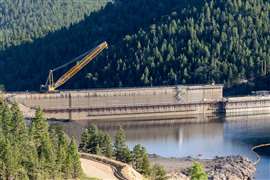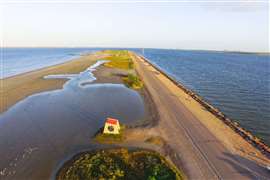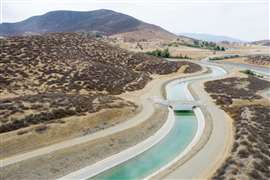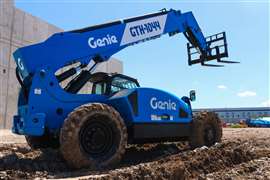Read this article in Français Deutsch Italiano Português Español
From toilet to the tap, construction starts for El Paso’s pioneering water-reuse project
25 March 2025
An unprecedented scheme in El Paso, Texas, US, has broken ground, with ambitions to be the nation’s first direct-to-distribution water reuse facility. Construction Briefing got the full scoop from main contractor PCL Construction Enterprises on this one-of-a-kind build.
 Officials from El Paso Water, alongside government members from local, state, and federal entities, conduct a ceremonial groundbreaking for the El Paso, Texas, Pure Water Center. (Image: PCL Construction)
Officials from El Paso Water, alongside government members from local, state, and federal entities, conduct a ceremonial groundbreaking for the El Paso, Texas, Pure Water Center. (Image: PCL Construction)
The City of El Paso, itself, is already unique.
It is surrounded by the Chihuahuan Desert, the Franklin Mountains range and Mexico; it is smackdab on the US-Mexico border and shares a metro with Mexican city Ciudad Juárez, which is just across the Rio Grande. Nearly 700,000 people live in El Paso proper with almost 200,000 more in the metro – and that’s not counting Mexico’s Ciudad Juárez metro, which, combined with El Paso’s, has nearly three million residents.
With the western United States often facing prolonged droughts and increasing water scarcity, these geographical and political quirks have meant the city’s water utility division (El Paso Water or EPWater) has been at the forefront of water reuse strategies for decades.
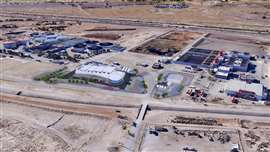 Aerial render of the Pure Water Center campus (Image courtesy PCL Construction)
Aerial render of the Pure Water Center campus (Image courtesy PCL Construction)
Already, the municipality relies on surface water, groundwater, and brackish desalination to meet the population’s needs. The city also operates an aquifer recharge programme, which injects treated wastewater into underground storage to replenish groundwater supplies for indirect potable reuse.
The combination of these efforts and their distinctiveness – the Kay Bailey Hutchison Desalination Plant in El Paso, for example, is the nation’s largest inland plant of its type – illustrate just how innovative this mid-sized Texan city has been regarding water distribution.
Now the municipality is constructing a brand-new Pure Water Center, the US’ first direct-to-distribution water reuse facility.
The project, managed by a joint venture led by US-based PCL Construction Enterprises (part of parent firm PCL Construction), will provide 10 million gallons per day (MGD) of high-quality drinking water, sourced from treated wastewater and purified through an advanced multi-stage process.
But before readers recoil at the thought of drinking from their toilet (which is not a fair comparison), read what Dana Lebeda, PCL Construction’s vice president of operations, had to say.
Project details for El Paso’s proactive approach to future water security
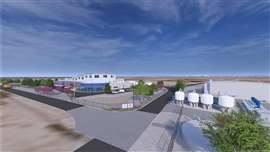 Render of the exterior of El Paso’s Pure Water Center, located in south Texas, US. (Image courtesy PCL Construction)
Render of the exterior of El Paso’s Pure Water Center, located in south Texas, US. (Image courtesy PCL Construction)
Lebeda notes EL Paso is not initiating this US$295-million strategy out of desperation.
“This is not a response to not having enough water,” says Lebeda. “It’s looking forward to where [El Paso] needs to be in the future.”
Lebeda tells Construction Briefing the Pure Water Center is nearly one decade in the making; serious discussion on the programme started around 2016.
For the desert city, which already uses multiple approaches to water and wastewater distribution, the next logical step was a direct potable reuse system. Different than aquifer recharging, direct reuse will introduce purified wastewater directly into the potable water system, rather than discharging it for indirect or non-potable uses.
“Since 2016, they’ve been working on planning all of this – piloting, a lot of public engagement, and eventually evolving into design.
“Now, we’re imminently beginning construction of the facility,” Lebeda says, noting a groundbreaking took place in late February.
And the Pure Water Center is just one part of El Paso’s overall approach to future-proofing its water network. Lebeda said PCL and JV partner Sundt Construction (US-based) are working on two other projects in the metro: upgrades to the Bustamante Wastewater Treatment Plant (which will supply the Pure Water Center) and the Haskell R. Street wastewater facility.
Combined with the Pure Water Project, PCL/Sundt JV has water/wastewater contracts valued up to $1.3 billion in the El Paso metro alone.
“This is a significant project that will require a peak workforce of 150 to 200 craft workers,” Lebeda says, noting the additional work across the city has the contractors carefully calculating labour figures. “We’re mindful of the strain this could put on the local craft population. But we’re working with strong subcontractors that have a great local workforce following, and we’re optimistic.”
The Pure Water Center project will be delivered using a CMAR model (Construction Manager at Risk), which Lebeda believes allows for a high level of coordination between the contractors, engineers, and EPWater.
“That’s important because it ensures we’re all aligned as one integrated team,” Lebeda says. “El Paso Water has been a fantastic partner, and we’re excited to collaborate with them through construction.”
A thorough approach to El Paso water purification
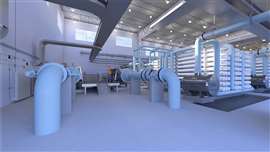 Storage tanks, part of the Pure Water Center purification system, inside the facility (Image courtesy PCL Construction)
Storage tanks, part of the Pure Water Center purification system, inside the facility (Image courtesy PCL Construction)
Because this facility will deliver water directly to consumers, EPWater and PCL/Sundt are installing a rigorous multi-barrier treatment system, which will be among the more interesting construction challenges.
“They’ve got a combination of microfiltration, reverse osmosis, ultraviolet advanced oxidation, granular activated carbon, and chlorine disinfection,” Lebeda explains.
He continues, “Typically, in a traditional water treatment facility using surface or groundwater, you’d see one or two of these processes.” But because this is project involves direct potable reuse, they’re taking a more thorough approach to ensure the water is of superior quality, he explains.
While none of these treatment processes are new, it is rare to see them all integrated into one system, Lebeda says.
“That’s one of the unique aspects of this project. It’s not necessarily the construction of the facility itself that’s challenging – we’ve built plants using these technologies before,” Lebeda adds.
“It’s that all of them are being used together in one place.”
The system was designed by California, US-based Carollo Engineers.
The challenge of commissioning El Paso’s Pure Water Center
 Part of the purification system at the Pure Water Center (Image courtesy PCL Construction)
Part of the purification system at the Pure Water Center (Image courtesy PCL Construction)
Another immense challenge for the project, Lebeda notes, will come during start-up and commissioning.
“Getting all those systems to work together and ensuring, through rigorous testing, that the final water quality meets all the standards before it’s distributed – that will be the key challenge,” he says.
In addition to ensuring the facility functions properly, public perception and engagement will also play a role in the project’s success.
“Historically, the topic of direct potable reuse has been sensitive to the public,” Lebeda acknowledges. “El Paso Water has done a fantastic job with early public engagement, but the challenge will be continuing that engagement throughout construction, commissioning, and when the water is finally delivered to the community.”
The most important detail: residents are not, in fact, drinking wastewater.
Public education and transparency will be a priority during construction, Lebeda says, adding, “It’s not uncommon for us to do public tours during construction. Obviously, public safety is our top priority, but these tours give the community a chance to see the progress firsthand and understand the advanced treatment processes that will ensure the water’s quality.”
As for the actual construction and the site, despite the scale of the project, disruption to the local community will be minimal.
“The site itself is fairly contained,” Lebeda says. “It’s almost a greenfield parcel adjacent to existing plants. The blending point for this water is not far from the plant, so there’s not a lot of new transmission pipeline required.”
EPWater setting a precedent for the industry?
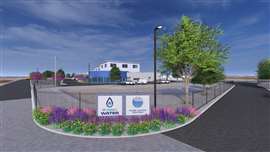 Render of the Pure Water Center in El Paso, Texas, US. (Image courtesy PCL Construction)
Render of the Pure Water Center in El Paso, Texas, US. (Image courtesy PCL Construction)
While El Paso’s Pure Water Center will be the first direct potable reuse facility in the US, it is highly unlikely to be the last.
“El Paso Water is the first utility to put a shovel in the ground for a direct potable reuse project, but we’re seeing municipalities in Arizona, Colorado, and other western states starting to look at this as a viable solution,” Lebeda says.
Nationwide, water infrastructure projects are on the rise, driven by aging infrastructure, population growth and regulatory changes. Analysts covering US construction expect water utility and energy sector construction activity to be high in 2025 and forward.
Reuse and recycling projects, too, are likely to increase with both internal and external sustainability expectations on the rise.
“The topic of reuse is one of the hottest in the industry right now,” Lebeda notes. “Major metropolitan areas are starting to plan for it, and this project will be a case study for others to follow.”
Timeline for El Paso’s Pure Water Center construction project
With major construction starts imminent, significant progress is expected over the next few years, with completion anticipated by late 2028.
“We’ve already started ordering long-lead-time equipment, and our team is mobilising on-site,” Lebeda says. “Things are ramping up, and we’re looking forward to delivering a facility that will set the standard for future water reuse projects.”
STAY CONNECTED


Receive the information you need when you need it through our world-leading magazines, newsletters and daily briefings.
CONNECT WITH THE TEAM









